Abstract
BACKGROUND AND AIMS: Fatty foods are commonly reported to aggravate gastro-oesophageal reflux symptoms. In this study the hypothesis that fat provokes reflux by stimulating transient lower oesophageal sphincter relaxations via small intestinal receptors was investigated. METHODS: In 12 healthy volunteers and 11 patients with reflux oesophagitis, oesophageal motility and pH were measured over 30 minute periods during which saline or fat (10% Intralipid) were infused in random order into the duodenum. The infusion periods were separated by a 30 minute washout. The stomach was loaded with 200 ml 10% dextrose, maintained by an intragastric infusion. RESULTS: Fat decreased basal LOS pressure from 16.9 (SEM 2.1) to 12.4 (SEM 1.5) mm Hg in normal subjects but had no effect in patients with oesophagitis (18.8 (SEM 4.3) v 18.2 (SEM 3.0) mm Hg). During saline infusion, the rates of transient lower oesophageal sphincter relaxation and reflux episodes were greater in patients (4.5 (interquartile range 2-11)/30 min and 5 (2-14)/30 min respectively) than in controls (3 (2-4)/30 min and 3 (2-3.5)/30 min respectively). Fat increased the rate of reflux episodes in the reflux patients to 6.5 (3-25)/30 min. This effect was due to an increase in the incidence of reflux during transient LOS relaxations (65% v 91%), the rate of transient relaxations remaining unchanged. CONCLUSIONS: Instillation of fat directly into the duodenum aggravates reflux in patients with reflux disease, by increasing the proportion of transient LOS relaxations accompanied by reflux.
Full text
PDF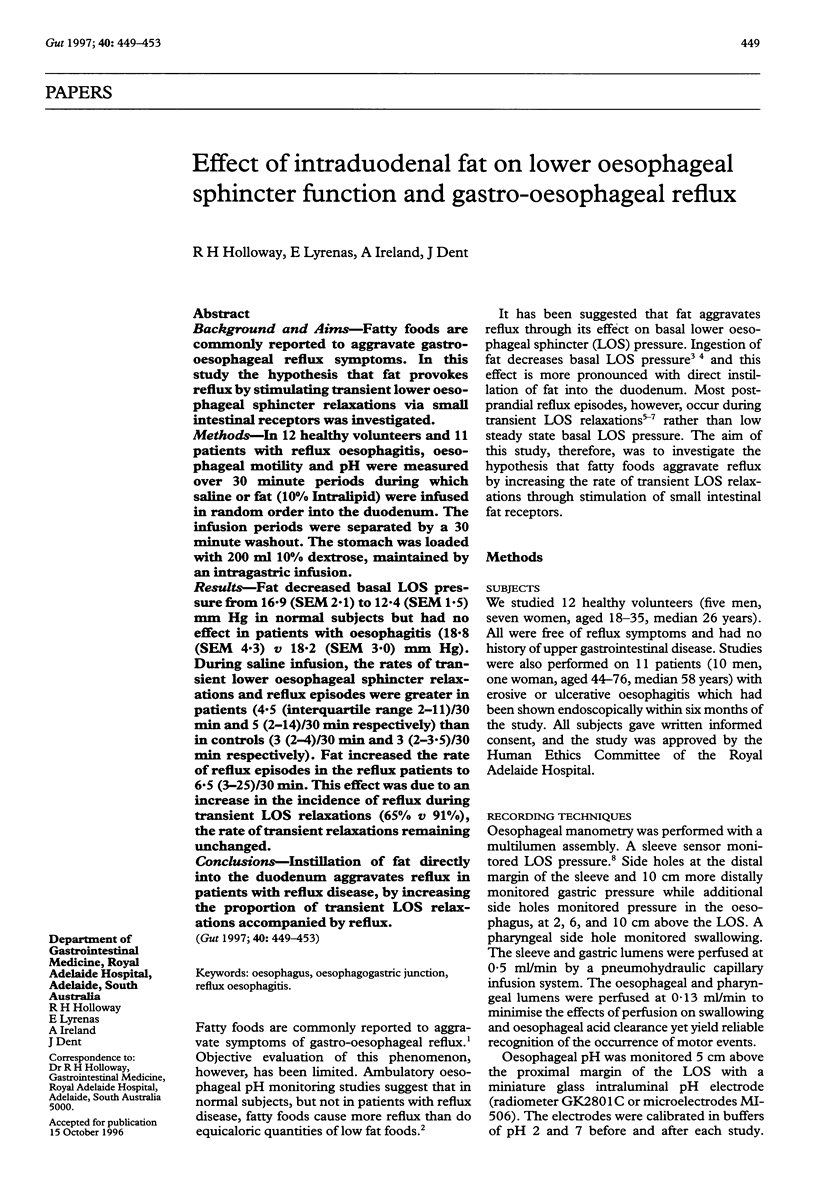
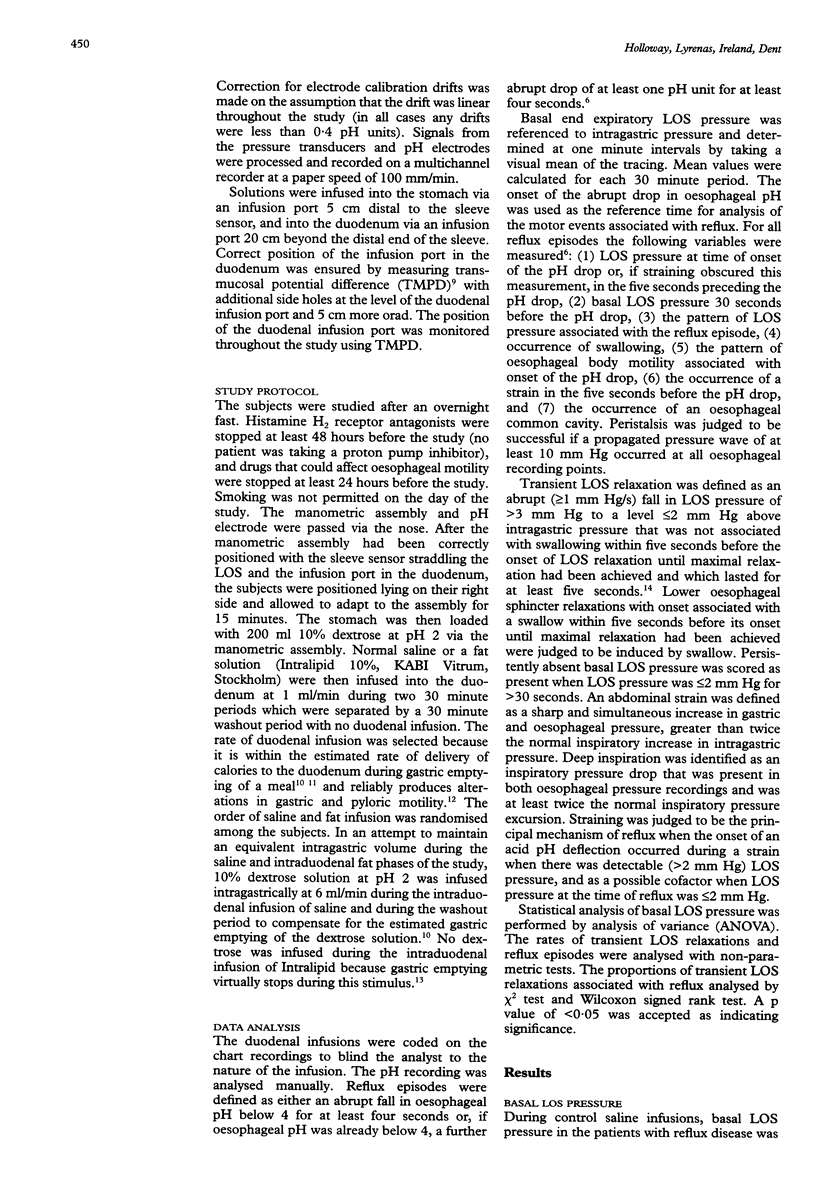
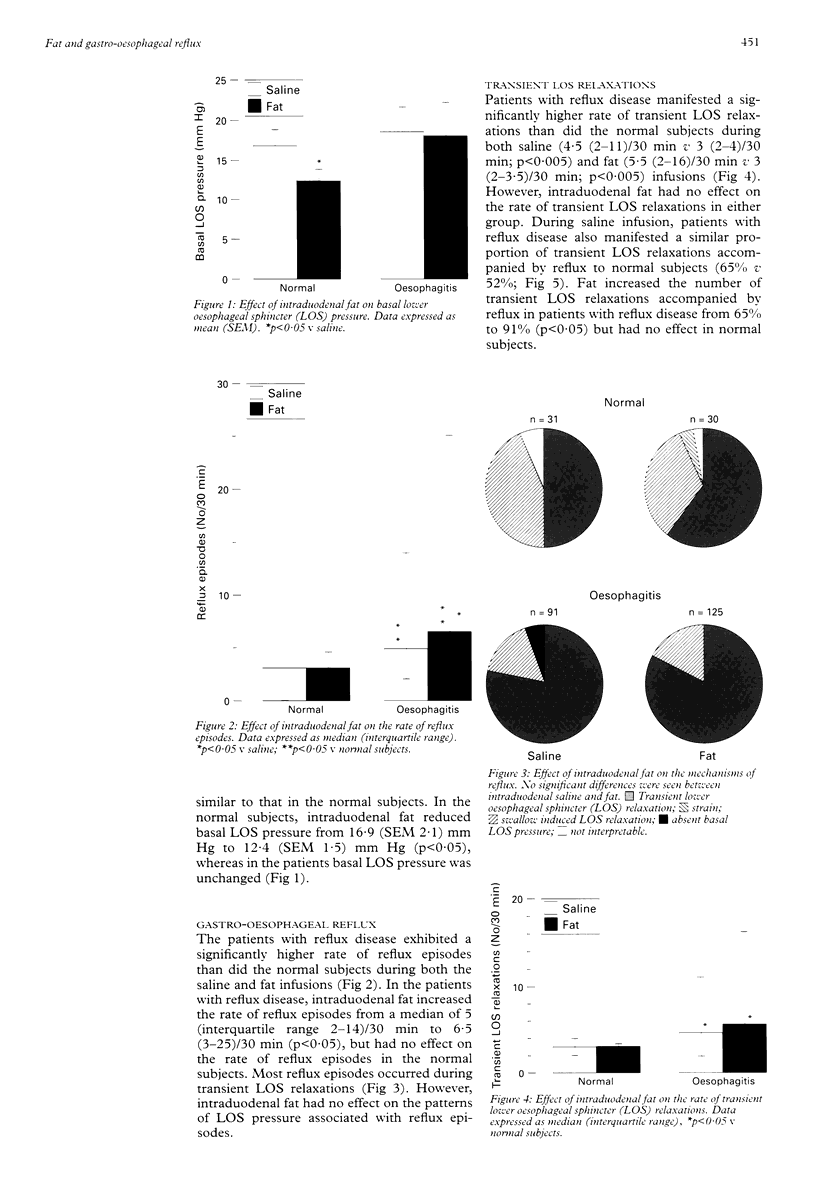
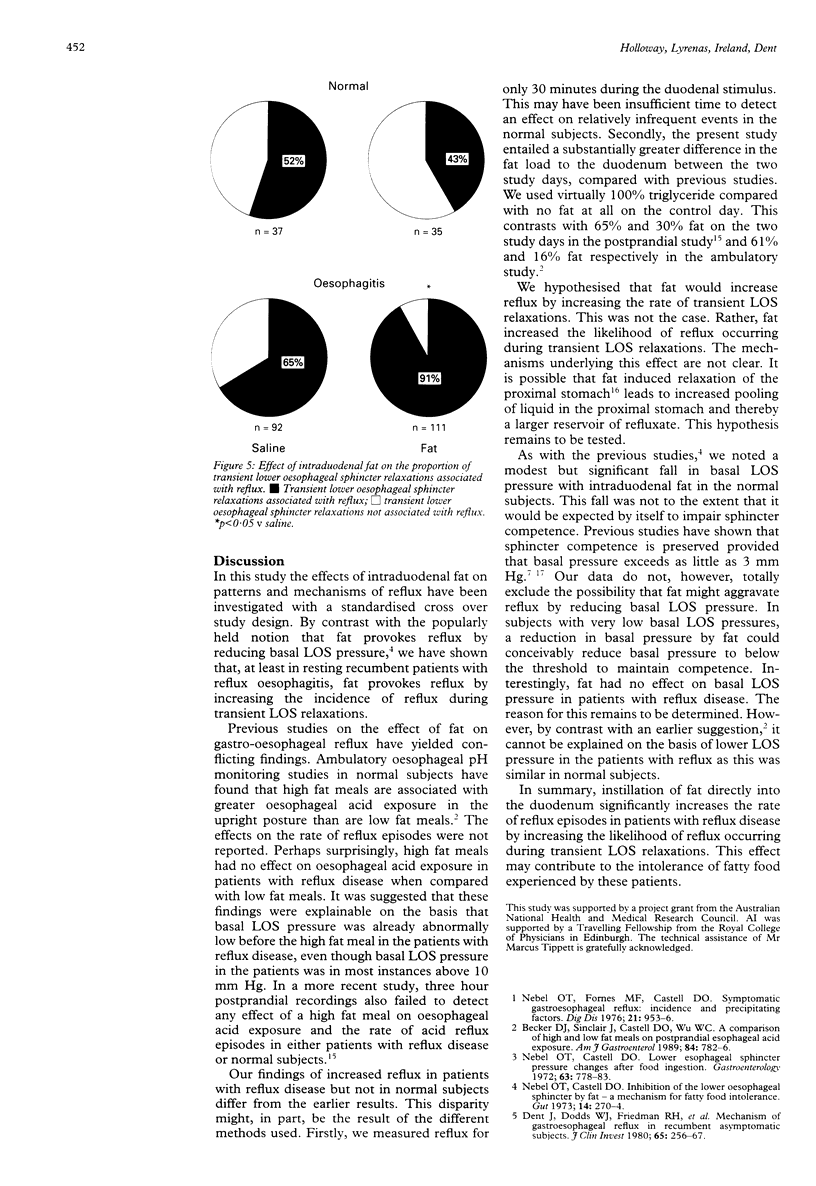
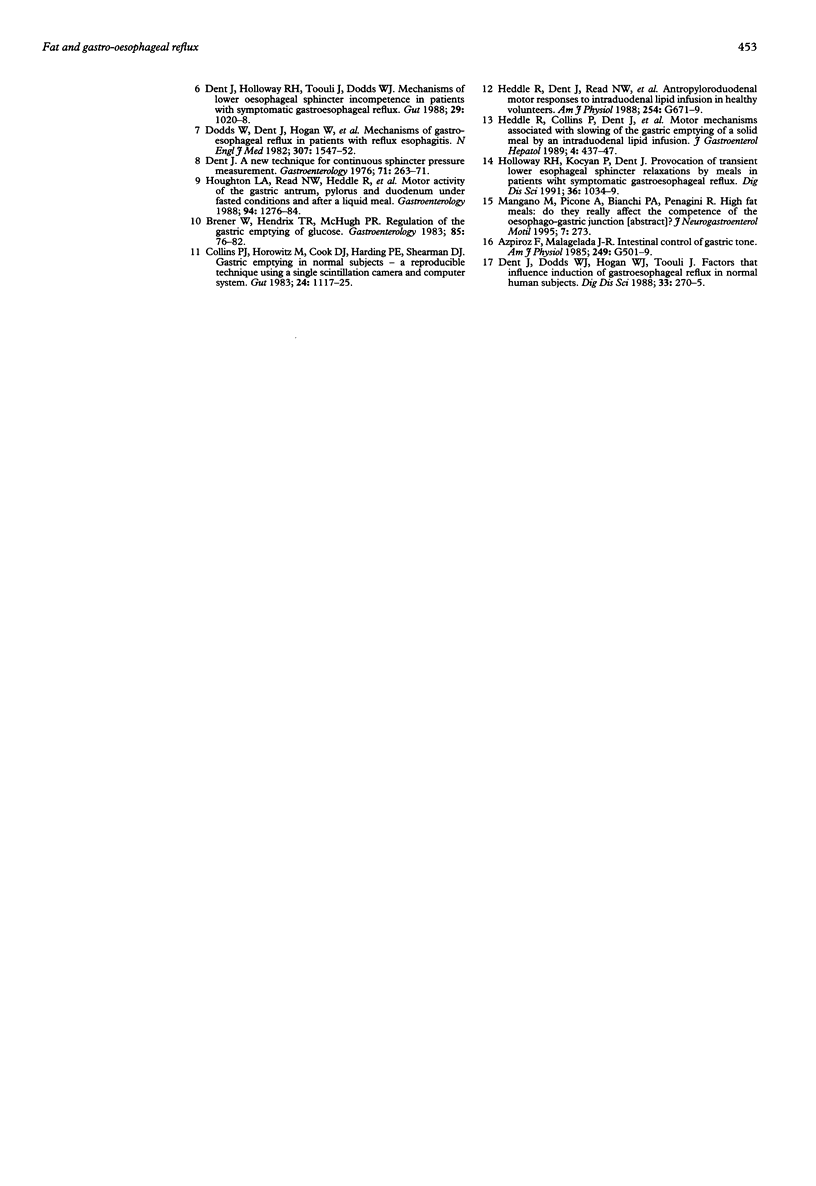
Selected References
These references are in PubMed. This may not be the complete list of references from this article.
- Azpiroz F., Malagelada J. R. Intestinal control of gastric tone. Am J Physiol. 1985 Oct;249(4 Pt 1):G501–G509. doi: 10.1152/ajpgi.1985.249.4.G501. [DOI] [PubMed] [Google Scholar]
- Becker D. J., Sinclair J., Castell D. O., Wu W. C. A comparison of high and low fat meals on postprandial esophageal acid exposure. Am J Gastroenterol. 1989 Jul;84(7):782–786. [PubMed] [Google Scholar]
- Brener W., Hendrix T. R., McHugh P. R. Regulation of the gastric emptying of glucose. Gastroenterology. 1983 Jul;85(1):76–82. [PubMed] [Google Scholar]
- Collins P. J., Horowitz M., Cook D. J., Harding P. E., Shearman D. J. Gastric emptying in normal subjects--a reproducible technique using a single scintillation camera and computer system. Gut. 1983 Dec;24(12):1117–1125. doi: 10.1136/gut.24.12.1117. [DOI] [PMC free article] [PubMed] [Google Scholar]
- Dent J. A new technique for continuous sphincter pressure measurement. Gastroenterology. 1976 Aug;71(2):263–267. [PubMed] [Google Scholar]
- Dent J., Dodds W. J., Friedman R. H., Sekiguchi T., Hogan W. J., Arndorfer R. C., Petrie D. J. Mechanism of gastroesophageal reflux in recumbent asymptomatic human subjects. J Clin Invest. 1980 Feb;65(2):256–267. doi: 10.1172/JCI109667. [DOI] [PMC free article] [PubMed] [Google Scholar]
- Dent J., Dodds W. J., Hogan W. J., Toouli J. Factors that influence induction of gastroesophageal reflux in normal human subjects. Dig Dis Sci. 1988 Mar;33(3):270–275. doi: 10.1007/BF01535748. [DOI] [PubMed] [Google Scholar]
- Dent J., Holloway R. H., Toouli J., Dodds W. J. Mechanisms of lower oesophageal sphincter incompetence in patients with symptomatic gastrooesophageal reflux. Gut. 1988 Aug;29(8):1020–1028. doi: 10.1136/gut.29.8.1020. [DOI] [PMC free article] [PubMed] [Google Scholar]
- Dodds W. J., Dent J., Hogan W. J., Helm J. F., Hauser R., Patel G. K., Egide M. S. Mechanisms of gastroesophageal reflux in patients with reflux esophagitis. N Engl J Med. 1982 Dec 16;307(25):1547–1552. doi: 10.1056/NEJM198212163072503. [DOI] [PubMed] [Google Scholar]
- Heddle R., Collins P. J., Dent J., Horowitz M., Read N. W., Chatterton B., Houghton L. A. Motor mechanisms associated with slowing of the gastric emptying of a solid meal by an intraduodenal lipid infusion. J Gastroenterol Hepatol. 1989 Sep-Oct;4(5):437–447. doi: 10.1111/j.1440-1746.1989.tb01741.x. [DOI] [PubMed] [Google Scholar]
- Heddle R., Dent J., Read N. W., Houghton L. A., Toouli J., Horowitz M., Maddern G. J., Downton J. Antropyloroduodenal motor responses to intraduodenal lipid infusion in healthy volunteers. Am J Physiol. 1988 May;254(5 Pt 1):G671–G679. doi: 10.1152/ajpgi.1988.254.5.G671. [DOI] [PubMed] [Google Scholar]
- Holloway R. H., Kocyan P., Dent J. Provocation of transient lower esophageal sphincter relaxations by meals in patients with symptomatic gastroesophageal reflux. Dig Dis Sci. 1991 Aug;36(8):1034–1039. doi: 10.1007/BF01297443. [DOI] [PubMed] [Google Scholar]
- Houghton L. A., Read N. W., Heddle R., Maddern G. J., Downton J., Toouli J., Dent J. Motor activity of the gastric antrum, pylorus, and duodenum under fasted conditions and after a liquid meal. Gastroenterology. 1988 Jun;94(6):1276–1284. doi: 10.1016/0016-5085(88)90664-6. [DOI] [PubMed] [Google Scholar]
- Nebel O. T., Castell D. O. Inhibition of the lower oesophageal sphincter by fat--a mechanism for fatty food intolerance. Gut. 1973 Apr;14(4):270–274. doi: 10.1136/gut.14.4.270. [DOI] [PMC free article] [PubMed] [Google Scholar]
- Nebel O. T., Castell D. O. Lower esophageal sphincter pressure changes after food ingestion. Gastroenterology. 1972 Nov;63(5):778–783. [PubMed] [Google Scholar]
- Nebel O. T., Fornes M. F., Castell D. O. Symptomatic gastroesophageal reflux: incidence and precipitating factors. Am J Dig Dis. 1976 Nov;21(11):953–956. doi: 10.1007/BF01071906. [DOI] [PubMed] [Google Scholar]


